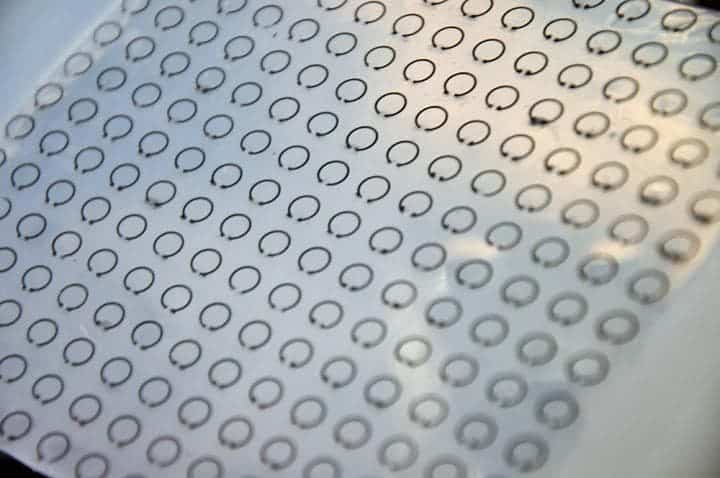Iowa State University engineers have created a flexible, tunable “meta-skin,” a material that uses rows of liquid-metal devices to cloak an object from radar detection.
The skin gets its names from metamaterials, a family of composite materials that have the ability to manipulate electromagnetic waves. By stretching or flexing the polymeric meta-skin, the way it interacts with such waves changes, allowing it to reduce reflection of a wide range of radar frequencies. This allows it to cloak objects from radar detection.

Image credits Liang Dong/Iowa State University.
“It is believed that the present meta-skin technology will find many applications in electromagnetic frequency tuning, shielding and scattering suppression,” the paper’s authors write.
Lead authors of the paper are Associate Professor Liang Dong, with a background in micro and nanoscale device fabrication as well as liquid and polymer studies and Professor Jiming Song, who is researching new applications for electromagnetic waves. Together, they wanted to prove that electromagnetic waves can be suppressed with flexible, tunable materials that incorporate liquid-metal technologies.
Their finished product is made up of rows of split ring-like resonating structures, fixed by layers of silicone sheets. The resonators have a 2.5mm radius and a thickness of half a millimeter, with a 1mm-wide gap between them. They’re filled with galinstan, a metal alloy that remains liquid at room temperatures and is less toxic than metals who share this property, such as mercury.
The rings function as electric inductors and the gaps between them create electric capacitors. Together they form a resonator that can trap and suppress radar waves of a certain frequency. Stretching the meta-skin alters the size and shape of the liquid metal rings inside and changes this frequency, allowing for a wide range of signals to be absorbed.
Testing showed that the material can suppress 75% of radar signals in the 8 to 10 gigahertz frequency range. If wrapped in the meta-skin, the radar waves “are suppressed in all incident directions and observation angles,” according to the paper.
“Therefore, this meta-skin technology is different from traditional stealth technologies that often only reduce the backscattering, i.e., the power reflected back to a probing radar,” the authors add.
One of the most obvious uses of the meta-skin is in military technology. As he discussed the meta-skin, Song also mentioned the B-2 stealth bomber. One day, he said, the meta-skin could coat the surface of the next generation of stealth aircraft. But the researchers are setting their sights even further – a cloak of invisibility.
“The long-term goal is to shrink the size of these devices,” Dong said.
“Then hopefully we can do this with higher-frequency electromagnetic waves such as visible or infrared light. While that would require advanced nanomanufacturing technologies and appropriate structural modifications, we think this study proves the concept of frequency tuning and broadening, and multidirectional wave suppression with skin-type metamaterials.”
The full paper, titled “From Flexible and Stretchable Meta-Atom to Metamaterial: A Wearable Microwave Meta-Skin with Tunable Frequency Selective and Cloaking Effects” has been published online in the journal Scientific Reports and can be read here.


